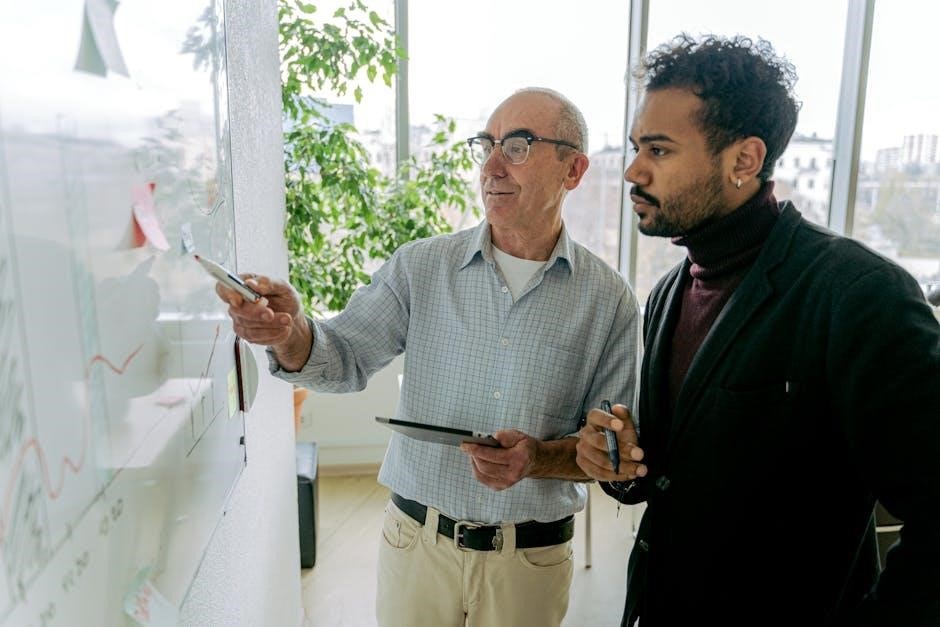Team development stages are crucial for success, according to research by Bruce Tuckman, an educational psychologist, who identified stages of team development pdf for effective teamwork and collaboration, using a model with four distinct stages always․
Overview of Team Development
Team development is a process that involves the growth and evolution of a team over time, as identified in stages of team development pdf․ This process is essential for teams to achieve their goals and objectives, and it requires effort and commitment from all team members․ According to research, team development is a critical component of organizational success, as it enables teams to work together effectively and efficiently․ The stages of team development pdf provide a framework for understanding the different stages that teams go through, from formation to maturity․ By understanding these stages, team leaders and members can take steps to support the development of their team, address challenges and conflicts, and foster a positive and productive team culture․ Effective team development is critical for achieving organizational goals, and it requires a deep understanding of the stages of team development and how to navigate them successfully․ Team development is an ongoing process that requires continuous effort and commitment․

Four Stages of Team Development
Team development stages include forming, storming, norming, and performing, as outlined in stages of team development pdf, providing a framework for team growth and development always effectively․
Stage 1 ⏤ Forming
At the forming stage, team members meet and learn about each other, establishing trust and defining their purpose, as discussed in stages of team development pdf․ This initial stage is crucial for setting the tone for future collaboration and teamwork․ Team members are often polite and enthusiastic, but also uncertain about their roles and responsibilities․ They begin to establish relationships and learn about each other’s strengths and weaknesses․ The forming stage is a time of orientation, where team members get to know each other and start to build a foundation for their work together․ According to research, this stage is characterized by a high level of dependence on the leader and a focus on defining the team’s goals and objectives․ As teams progress through this stage, they begin to develop a sense of identity and purpose, which is essential for their future success․ The forming stage is the foundation upon which the rest of the team development process is built, and its importance should not be underestimated․ Effective leadership and communication are critical during this stage, as they help to establish a positive and productive team culture․
Stage 2 ⏤ Storming

The storming stage is a critical phase in the team development process, as discussed in stages of team development pdf․ During this stage, team members begin to challenge each other and the leader, as they clarify their roles and responsibilities․ Conflict and competition arise as individuals assert their opinions and ideas, and the team’s dynamics become more complex․ The storming stage is characterized by a high level of emotion and tension, as team members navigate their differences and work to establish a sense of unity and purpose․ As teams navigate this stage, they must learn to manage conflict and communicate effectively, in order to build trust and establish a strong foundation for future collaboration․ The storming stage is a time of testing and refinement, where team members learn to work through their differences and develop a sense of cohesion and teamwork․ Effective leadership and communication are essential during this stage, as they help to guide the team through the challenges and uncertainties of the storming phase․ By working through their differences, teams can emerge from the storming stage stronger and more resilient, with a deeper understanding of each other and a clearer sense of purpose․

Understanding the Norming Stage
Team members develop a sense of unity and cooperation, establishing norms and standards for communication and collaboration, as outlined in stages of team development pdf, to achieve common goals effectively always․
Stage 3 ⏤ Norming
During this stage, team members develop a sense of unity and cooperation, establishing norms and standards for communication and collaboration, as outlined in stages of team development pdf․ They begin to share a common vision and goals, and a sense of trust and camaraderie develops among team members․ The team starts to function as a cohesive unit, with each member contributing their skills and expertise to achieve common objectives․ As the team progresses through this stage, they learn to appreciate each other’s strengths and weaknesses, and a sense of mutual respect and understanding develops․ The norming stage is critical in building a strong and effective team, as it lays the foundation for future success and collaboration․ Team members learn to work together seamlessly, and the team becomes a well-oiled machine, with each member playing a vital role in achieving the team’s goals and objectives, as described in the stages of team development pdf model․

Final Stage of Team Development
The final stage is characterized by high productivity, teamwork, and collaboration, as teams reach their full potential, working efficiently towards common goals, as outlined in stages of team development pdf models always effectively․
Stage 4 ౼ Performing
The performing stage is the final stage of team development, where teams are able to work together seamlessly, achieving their goals and objectives with ease and efficiency․ At this stage, team members have learned to work together, trust each other, and rely on each other’s strengths to achieve success․ They are able to manage conflicts and challenges effectively, and are motivated to achieve their goals․ The performing stage is characterized by high productivity, job satisfaction, and a sense of accomplishment․ Team members are able to take ownership of their work, and are accountable for their actions․ The team is able to adapt to changes and challenges, and is able to continuously improve and grow․ The performing stage is the ultimate goal of team development, where teams are able to reach their full potential and achieve great things․ This stage is a key part of the stages of team development pdf, and is essential for teams to achieve success and reach their goals․ With effective leadership and management, teams can reach the performing stage and achieve great things․ Effective communication and collaboration are key to achieving this stage․
Importance of Team Development Stages
The importance of team development stages cannot be overstated, as they play a crucial role in the success and effectiveness of teams․ Understanding the stages of team development, as outlined in the stages of team development pdf, is essential for leaders and team members to navigate the challenges and opportunities that arise during the team development process․ By recognizing the different stages, teams can better manage conflicts, improve communication, and increase collaboration․ The stages of team development also provide a framework for leaders to develop strategies to support their teams, foster growth and development, and promote a positive and productive team culture․ Furthermore, understanding the team development stages can help teams to identify areas for improvement, develop solutions to common challenges, and create a sense of unity and purpose․ Overall, the importance of team development stages lies in their ability to help teams achieve their goals, improve performance, and reach their full potential․ Effective team development is critical to achieving success in today’s fast-paced and rapidly changing work environment․ Teams that understand and apply the stages of team development are better equipped to succeed․

No Responses